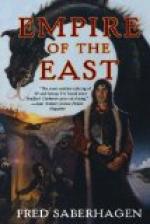As our carriage drew up before the little hostelry, a crowd of boys were standing in front of a house opposite, which is half telegraph office and half school, for economy in buildings is practised in Montenegro. They saluted us smartly in military fashion. The born soldier is noticed at once, even in the small children; many generations of fighting ancestors have bequeathed a smartness and accuracy of movement which can be envied by many a Continental trained conscript.
The traveller meets with little attention either here or in Cetinje. It is not till he gets well off the beaten track that he sees the hospitable and courteous Montenegrin as he really is.
[Illustration: NJEGUSI]
[Illustration: THE GUSLAR]
During our frugal breakfast of raw ham and goat’s cheese, our ears were assailed by the singing of the guslar, or Montenegrin troubadour. The guslars, we noticed, are invariably blind, and as no previous musical education seems necessary, it would appear to be a monopoly of those so afflicted. Their singing is execrable according to Western notions, a range of four or five notes in a wailing minor key making up their register, and they accompany themselves on an instrument (the gusla) from which they derive their name. It is hand-made, resembling a cross between a violin and a mandolin. It possesses one string, and is played with a short curved bow. With careful handling, a series of discordant notes of wearying monotony can be produced. The performance is altogether most doleful.
Yet they are the history books, the legend tellers of the country. They fan the fire of patriotism and loyalty by songs of the deeds and accomplishments of their Prince, of dead heroes and past glorious battles, and form another link with the mediaeval world of which the traveller is so strongly reminded at every step in Montenegro.
As we left the village we passed the birthplace of Prince Nicolas I., though the palace appears to have been entirely rebuilt. In nearly every town or village of importance the Prince has a house, varying considerably in size, but of equally unpretentious exterior.
The road still climbs and reaches the maximum height of three thousand five hundred feet. From this altitude it steadily drops into Cetinje, which lies about two thousand feet above the sea-level. The scenery is unvarying, but not without beauty. It is essentially wild, but the light colour of the rocks and the numerous shrubs which find a footing in the crevices minimise the forbidding character of the country. The land is magnificently adapted for guerilla warfare, where every foot can be contested. Little patches of earth, washed down the hillsides, lie in every hollow, and have been utilised by the careful peasant to grow his tiny crops.
After about seven hours’ driving, Cetinje appears in sight, at the end of a long valley, and completely surrounded by the characteristic naked and rugged rocks. The road descends by another series of serpentines, and a long straight drive brings us into the town. The valley is about four miles long and three-quarters of a mile broad and absolutely flat.




